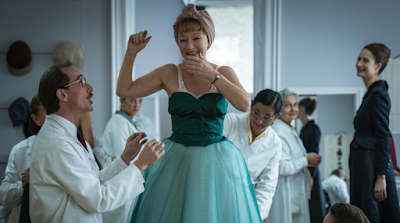If it's very much the kind of film British cinema does, it's also - crucially - the kind of film British cinema does, done surprisingly well. Unlike the sparsely populated See How They Run, this co-production has money to spend on extras, dresses and fittings, its centrepiece a fully ten-minute showcase of the lavish goods Dior was hawking to Parisian high society circa 1957; it has both life and some creative vim about it. There's an ensemble of British and French character actors, worn lightly: Christian McKay as a running-gag roué who introduces Mrs. H to a different "niece" each morning, Jason Isaacs typically foursquare as an Irish bookie with a soft spot for our heroine, Lambert Wilson super-smooth as a marquis who escorts Ada out of a nasty scene upon her arrival over the Channel. Director Anthony Fabian troubles to make everyone look good: in Paris, the men are insanely handsome, the women exceedingly pretty, and even Isabelle Huppert has been dolled up as Dior's control-freak gatekeeper. (There's a perverse thrill about seeing one of Europe's most daring actors in a British tea-and-biscuits movie.) Manville, bless her, is busy making Ada Harris a genuine character in the Mike Leigh vein, gradually paring back the chirpy mannerism to suggest an inner life only this one dress can properly express. No film has better explained to me, a lumpen recluse typically clad in potato sacks, the function and appeal of fashion - and that's because this narrative invites us to view fashion through the eyes of a woman who's worked hard her whole life and just wants to feel special. The film is special, too: finely, carefully tailored - a midfilm insert of a red ribbon being cut is deluxe ASMR if ever I encountered it - and with a ratio of charm-to-calculation unlike anything else now in the multiplex. Maybe we needed a thoroughly 20th century proposition to refute the most insidious of 21st century memes: we can still have nice things.
Mrs. Harris Goes to Paris is now screening in cinemas nationwide.

No comments:
Post a Comment